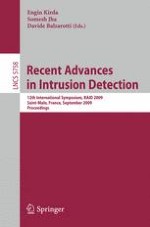2009 | OriginalPaper | Buchkapitel
Adaptive Anomaly Detection via Self-calibration and Dynamic Updating
verfasst von : Gabriela F. Cretu-Ciocarlie, Angelos Stavrou, Michael E. Locasto, Salvatore J. Stolfo
Erschienen in: Recent Advances in Intrusion Detection
Verlag: Springer Berlin Heidelberg
Aktivieren Sie unsere intelligente Suche, um passende Fachinhalte oder Patente zu finden.
Wählen Sie Textabschnitte aus um mit Künstlicher Intelligenz passenden Patente zu finden. powered by
Markieren Sie Textabschnitte, um KI-gestützt weitere passende Inhalte zu finden. powered by
The deployment and use of Anomaly Detection (AD) sensors often requires the intervention of a human expert to manually calibrate and optimize their performance. Depending on the site and the type of traffic it receives, the operators might have to provide recent and sanitized training data sets, the characteristics of expected traffic (
i.e.
outlier ratio), and exceptions or even expected future modifications of system’s behavior. In this paper, we study the potential performance issues that stem from fully automating the AD sensors’ day-to-day maintenance and calibration. Our goal is to remove the dependence on human operator using an unlabeled, and thus potentially dirty, sample of incoming traffic.
To that end, we propose to enhance the training phase of AD sensors with a self-calibration phase, leading to the automatic determination of the optimal AD parameters. We show how this novel calibration phase can be employed in conjunction with previously proposed methods for training data sanitization resulting in a fully automated AD maintenance cycle. Our approach is completely agnostic to the underlying AD sensor algorithm. Furthermore, the self-calibration can be applied in an online fashion to ensure that the resulting AD models reflect changes in the system’s behavior which would otherwise render the sensor’s internal state inconsistent. We verify the validity of our approach through a series of experiments where we compare the manually obtained optimal parameters with the ones computed from the self-calibration phase. Modeling traffic from two different sources, the fully automated calibration shows a 7.08% reduction in detection rate and a 0.06% increase in false positives, in the worst case, when compared to the optimal selection of parameters. Finally, our adaptive models outperform the statically generated ones retaining the gains in performance from the sanitization process over time.
